Analyzing JTI's CSR Performance Under Sustainability Theories
VerifiedAdded on 2019/10/18
|16
|3613
|207
Report
AI Summary
This report provides an in-depth analysis of Japan Tobacco International (JTI)'s corporate social responsibility (CSR) initiatives within the context of the tobacco industry. It explores the challenges of implementing sustainability practices for a company whose primary product has negative health impacts. The report examines JTI's CSR strategies through the lens of various sustainability theories, including the triple bottom line, social contract theory, and stakeholder theory. It assesses how JTI attempts to balance economic interests with social and environmental responsibilities, considering the ethical dilemmas inherent in the industry. The analysis includes a discussion of JTI's approach to its stakeholders, including employees, consumers, and communities, and evaluates the effectiveness of its CSR efforts in mitigating the negative consequences of its products. The report concludes with a discussion of the overall sustainability of JTI's business model and provides recommendations for future CSR strategies.
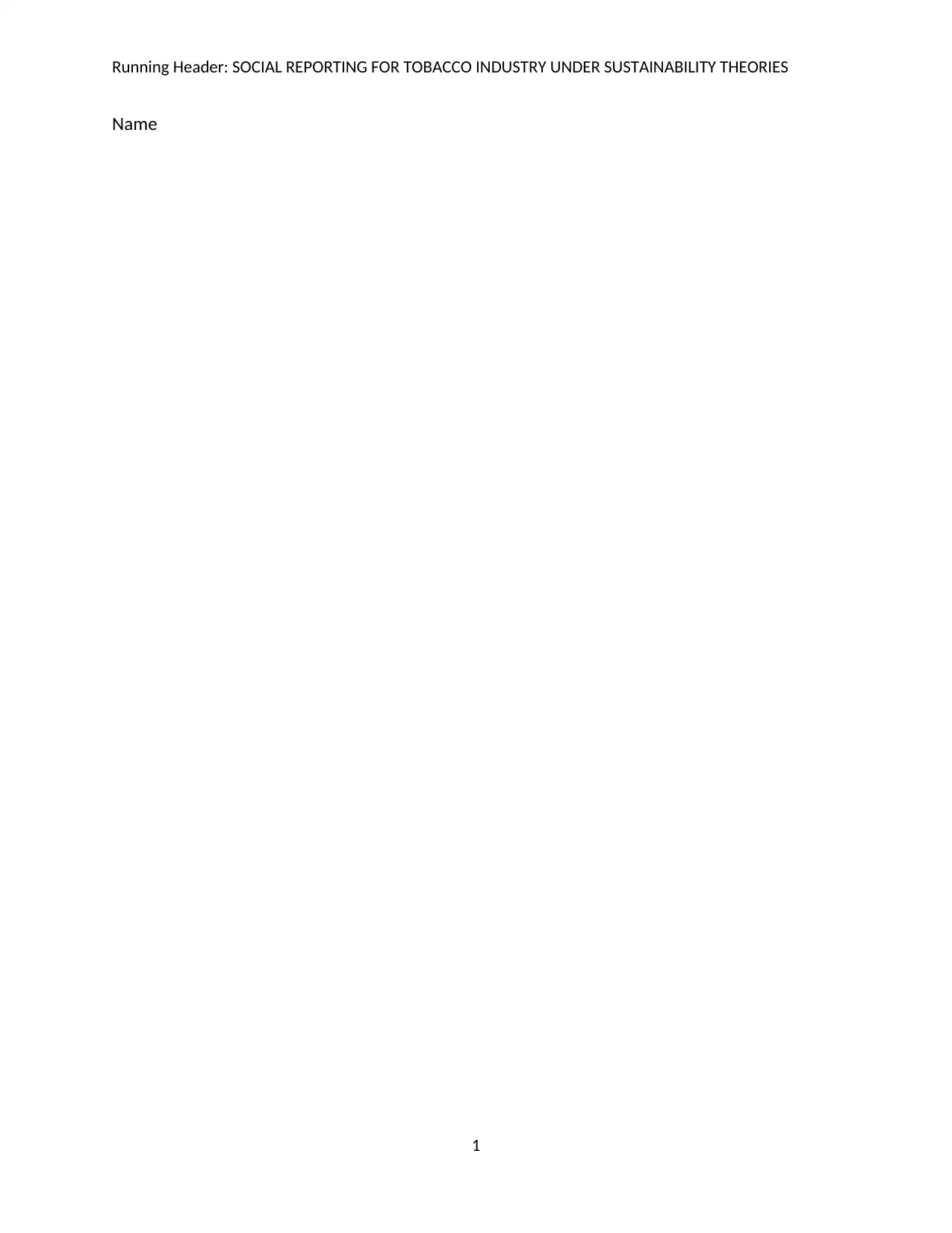
Running Header: SOCIAL REPORTING FOR TOBACCO INDUSTRY UNDER SUSTAINABILITY THEORIES
Name
1
Name
1
Paraphrase This Document
Need a fresh take? Get an instant paraphrase of this document with our AI Paraphraser
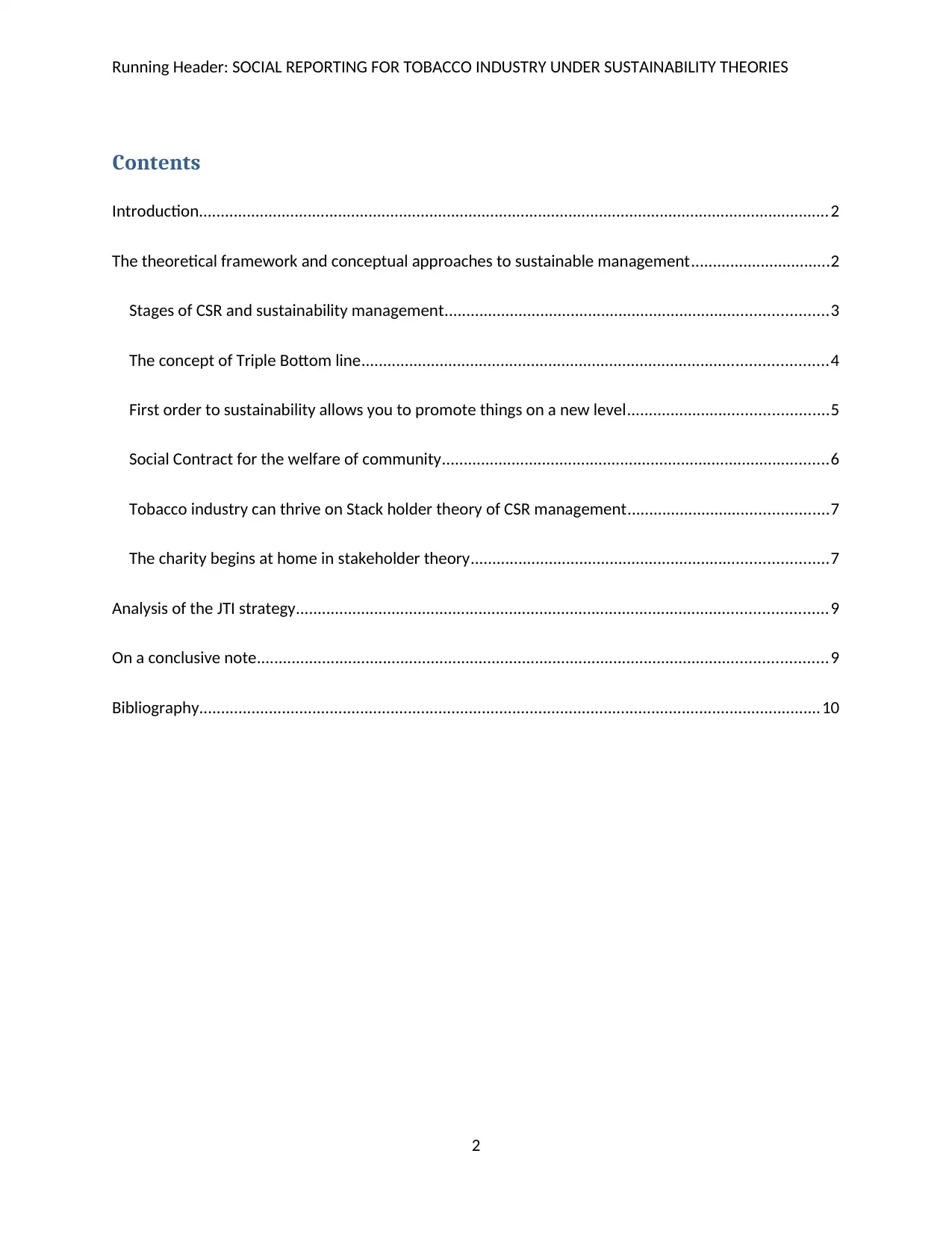
Running Header: SOCIAL REPORTING FOR TOBACCO INDUSTRY UNDER SUSTAINABILITY THEORIES
Contents
Introduction.................................................................................................................................................2
The theoretical framework and conceptual approaches to sustainable management................................2
Stages of CSR and sustainability management........................................................................................3
The concept of Triple Bottom line...........................................................................................................4
First order to sustainability allows you to promote things on a new level..............................................5
Social Contract for the welfare of community.........................................................................................6
Tobacco industry can thrive on Stack holder theory of CSR management..............................................7
The charity begins at home in stakeholder theory..................................................................................7
Analysis of the JTI strategy..........................................................................................................................9
On a conclusive note...................................................................................................................................9
Bibliography...............................................................................................................................................10
2
Contents
Introduction.................................................................................................................................................2
The theoretical framework and conceptual approaches to sustainable management................................2
Stages of CSR and sustainability management........................................................................................3
The concept of Triple Bottom line...........................................................................................................4
First order to sustainability allows you to promote things on a new level..............................................5
Social Contract for the welfare of community.........................................................................................6
Tobacco industry can thrive on Stack holder theory of CSR management..............................................7
The charity begins at home in stakeholder theory..................................................................................7
Analysis of the JTI strategy..........................................................................................................................9
On a conclusive note...................................................................................................................................9
Bibliography...............................................................................................................................................10
2

Running Header: SOCIAL REPORTING FOR TOBACCO INDUSTRY UNDER SUSTAINABILITY THEORIES
Introduction
CSR activities coming from the side of tobacco company sounds like the devil is donating
medicines to its victims. When we check out the initial footprints of tobacco in ancient history,
then we find that they were using it for medicinal purposes. However, with a passage of time,
first, it became a source of recreational thing and finally, it became a habit-forming menace.
Defining a CSR activity for a company selling tobacco can be a tricky job in many ways. The
realms of social responsibility say that if the number of people using tobacco is increasing then
it is not sustainability. It is a catch 22 situation for most of the tobacco selling companies; they
cannot kill their own business with their own hands. Three decades ago, the weather changed
in the favor of tobacco companies when the practice of “stakeholder’s sustainability practices”
started.
If a company is not getting enough profits out of its operations, then again it is not
sustainability. Tobacco and related products have a great multiplier, the create employment for
economically poor people. The retail business of tobacco is a business with minimum entry
barriers. Considering the above-mentioned facts, we simply cannot write off tobacco industry
completely.
It is a tricky job to fix a sustainability model for tobacco companies. The current study is an
attempt to handle the contrast associated with the tobacco industry, its CSR profiles and how
certain sustainability theories can be implemented for best result by cutting the bad impacts.
(Viccere, 2012)
3
Introduction
CSR activities coming from the side of tobacco company sounds like the devil is donating
medicines to its victims. When we check out the initial footprints of tobacco in ancient history,
then we find that they were using it for medicinal purposes. However, with a passage of time,
first, it became a source of recreational thing and finally, it became a habit-forming menace.
Defining a CSR activity for a company selling tobacco can be a tricky job in many ways. The
realms of social responsibility say that if the number of people using tobacco is increasing then
it is not sustainability. It is a catch 22 situation for most of the tobacco selling companies; they
cannot kill their own business with their own hands. Three decades ago, the weather changed
in the favor of tobacco companies when the practice of “stakeholder’s sustainability practices”
started.
If a company is not getting enough profits out of its operations, then again it is not
sustainability. Tobacco and related products have a great multiplier, the create employment for
economically poor people. The retail business of tobacco is a business with minimum entry
barriers. Considering the above-mentioned facts, we simply cannot write off tobacco industry
completely.
It is a tricky job to fix a sustainability model for tobacco companies. The current study is an
attempt to handle the contrast associated with the tobacco industry, its CSR profiles and how
certain sustainability theories can be implemented for best result by cutting the bad impacts.
(Viccere, 2012)
3
⊘ This is a preview!⊘
Do you want full access?
Subscribe today to unlock all pages.

Trusted by 1+ million students worldwide
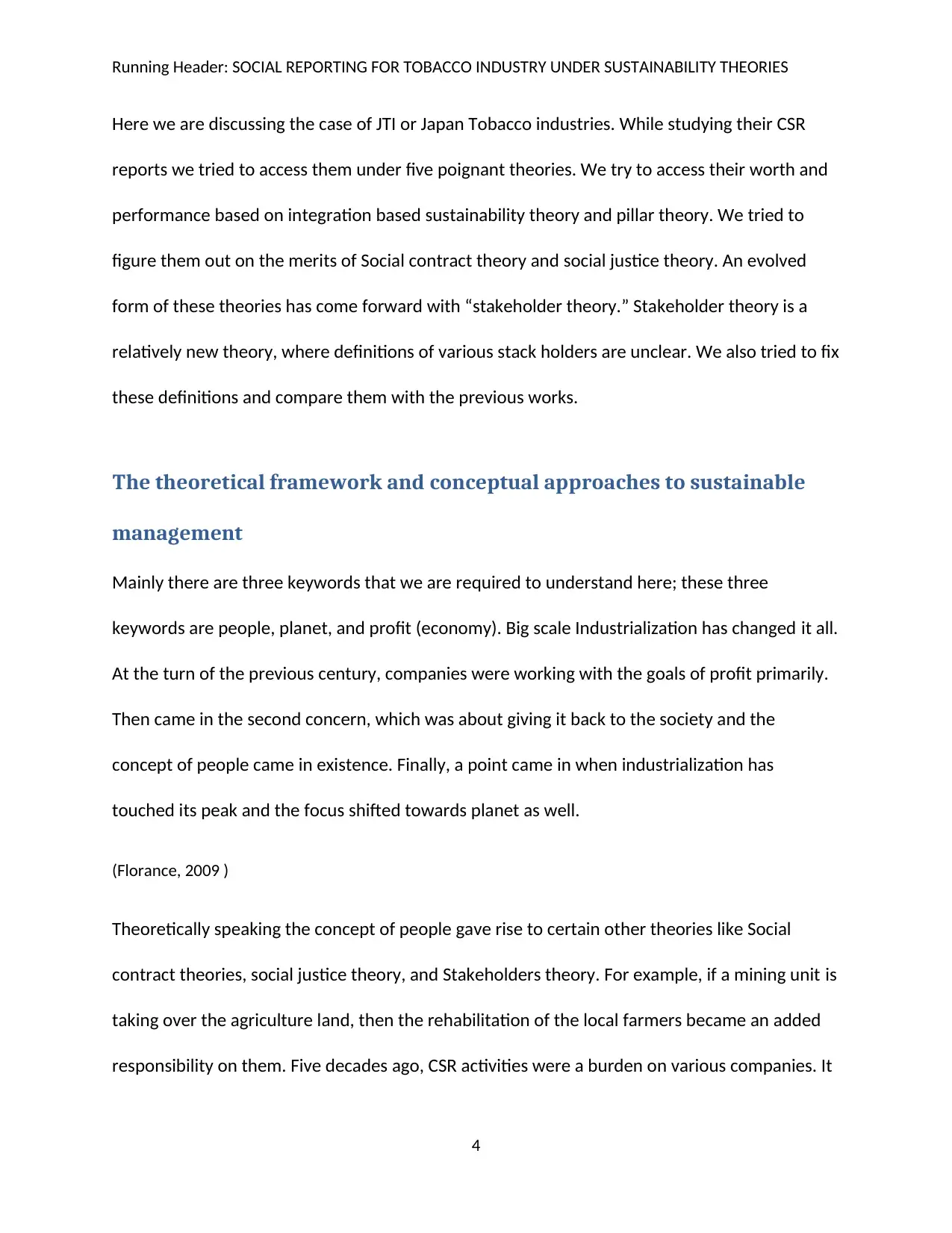
Running Header: SOCIAL REPORTING FOR TOBACCO INDUSTRY UNDER SUSTAINABILITY THEORIES
Here we are discussing the case of JTI or Japan Tobacco industries. While studying their CSR
reports we tried to access them under five poignant theories. We try to access their worth and
performance based on integration based sustainability theory and pillar theory. We tried to
figure them out on the merits of Social contract theory and social justice theory. An evolved
form of these theories has come forward with “stakeholder theory.” Stakeholder theory is a
relatively new theory, where definitions of various stack holders are unclear. We also tried to fix
these definitions and compare them with the previous works.
The theoretical framework and conceptual approaches to sustainable
management
Mainly there are three keywords that we are required to understand here; these three
keywords are people, planet, and profit (economy). Big scale Industrialization has changed it all.
At the turn of the previous century, companies were working with the goals of profit primarily.
Then came in the second concern, which was about giving it back to the society and the
concept of people came in existence. Finally, a point came in when industrialization has
touched its peak and the focus shifted towards planet as well.
(Florance, 2009 )
Theoretically speaking the concept of people gave rise to certain other theories like Social
contract theories, social justice theory, and Stakeholders theory. For example, if a mining unit is
taking over the agriculture land, then the rehabilitation of the local farmers became an added
responsibility on them. Five decades ago, CSR activities were a burden on various companies. It
4
Here we are discussing the case of JTI or Japan Tobacco industries. While studying their CSR
reports we tried to access them under five poignant theories. We try to access their worth and
performance based on integration based sustainability theory and pillar theory. We tried to
figure them out on the merits of Social contract theory and social justice theory. An evolved
form of these theories has come forward with “stakeholder theory.” Stakeholder theory is a
relatively new theory, where definitions of various stack holders are unclear. We also tried to fix
these definitions and compare them with the previous works.
The theoretical framework and conceptual approaches to sustainable
management
Mainly there are three keywords that we are required to understand here; these three
keywords are people, planet, and profit (economy). Big scale Industrialization has changed it all.
At the turn of the previous century, companies were working with the goals of profit primarily.
Then came in the second concern, which was about giving it back to the society and the
concept of people came in existence. Finally, a point came in when industrialization has
touched its peak and the focus shifted towards planet as well.
(Florance, 2009 )
Theoretically speaking the concept of people gave rise to certain other theories like Social
contract theories, social justice theory, and Stakeholders theory. For example, if a mining unit is
taking over the agriculture land, then the rehabilitation of the local farmers became an added
responsibility on them. Five decades ago, CSR activities were a burden on various companies. It
4
Paraphrase This Document
Need a fresh take? Get an instant paraphrase of this document with our AI Paraphraser
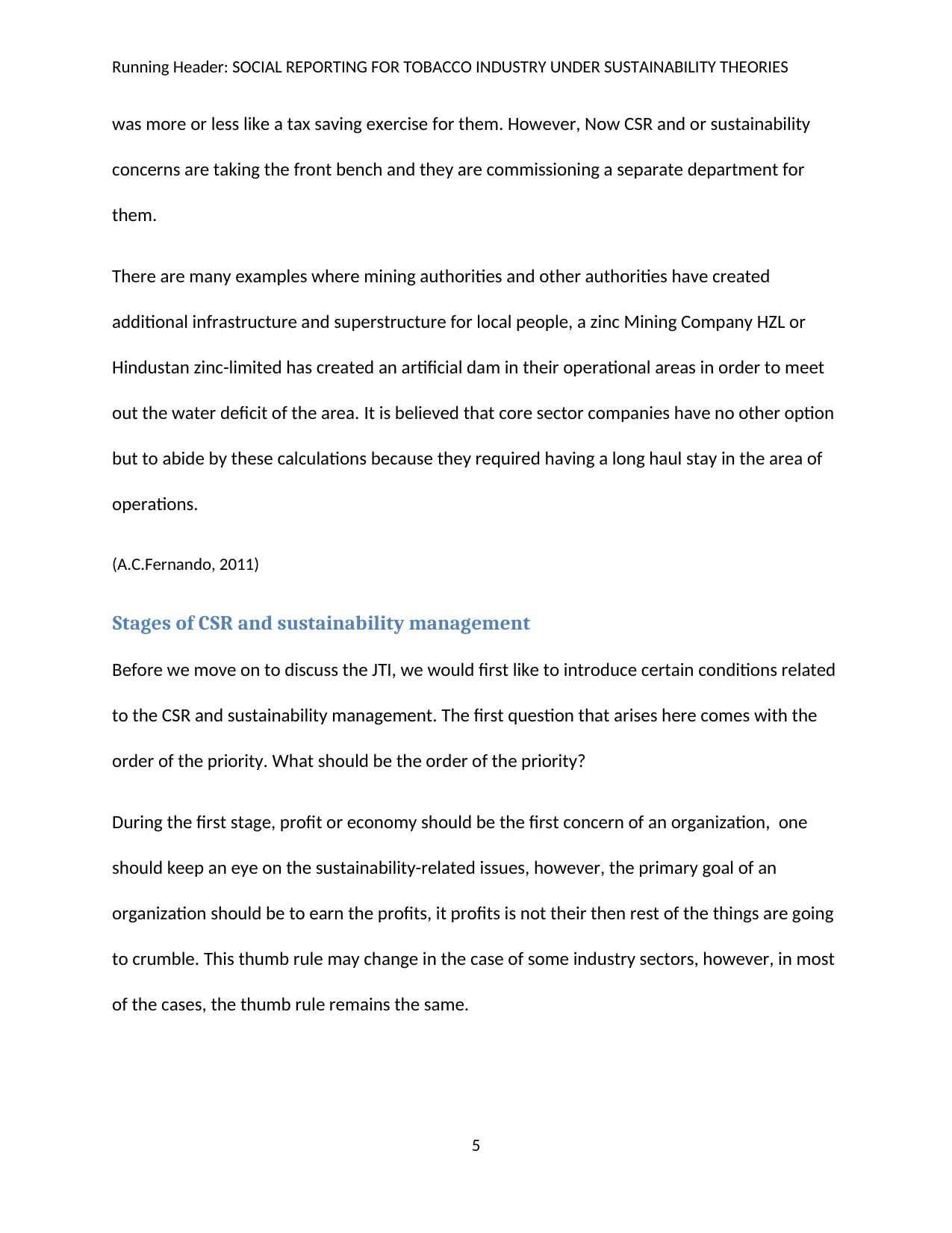
Running Header: SOCIAL REPORTING FOR TOBACCO INDUSTRY UNDER SUSTAINABILITY THEORIES
was more or less like a tax saving exercise for them. However, Now CSR and or sustainability
concerns are taking the front bench and they are commissioning a separate department for
them.
There are many examples where mining authorities and other authorities have created
additional infrastructure and superstructure for local people, a zinc Mining Company HZL or
Hindustan zinc-limited has created an artificial dam in their operational areas in order to meet
out the water deficit of the area. It is believed that core sector companies have no other option
but to abide by these calculations because they required having a long haul stay in the area of
operations.
(A.C.Fernando, 2011)
Stages of CSR and sustainability management
Before we move on to discuss the JTI, we would first like to introduce certain conditions related
to the CSR and sustainability management. The first question that arises here comes with the
order of the priority. What should be the order of the priority?
During the first stage, profit or economy should be the first concern of an organization, one
should keep an eye on the sustainability-related issues, however, the primary goal of an
organization should be to earn the profits, it profits is not their then rest of the things are going
to crumble. This thumb rule may change in the case of some industry sectors, however, in most
of the cases, the thumb rule remains the same.
5
was more or less like a tax saving exercise for them. However, Now CSR and or sustainability
concerns are taking the front bench and they are commissioning a separate department for
them.
There are many examples where mining authorities and other authorities have created
additional infrastructure and superstructure for local people, a zinc Mining Company HZL or
Hindustan zinc-limited has created an artificial dam in their operational areas in order to meet
out the water deficit of the area. It is believed that core sector companies have no other option
but to abide by these calculations because they required having a long haul stay in the area of
operations.
(A.C.Fernando, 2011)
Stages of CSR and sustainability management
Before we move on to discuss the JTI, we would first like to introduce certain conditions related
to the CSR and sustainability management. The first question that arises here comes with the
order of the priority. What should be the order of the priority?
During the first stage, profit or economy should be the first concern of an organization, one
should keep an eye on the sustainability-related issues, however, the primary goal of an
organization should be to earn the profits, it profits is not their then rest of the things are going
to crumble. This thumb rule may change in the case of some industry sectors, however, in most
of the cases, the thumb rule remains the same.
5
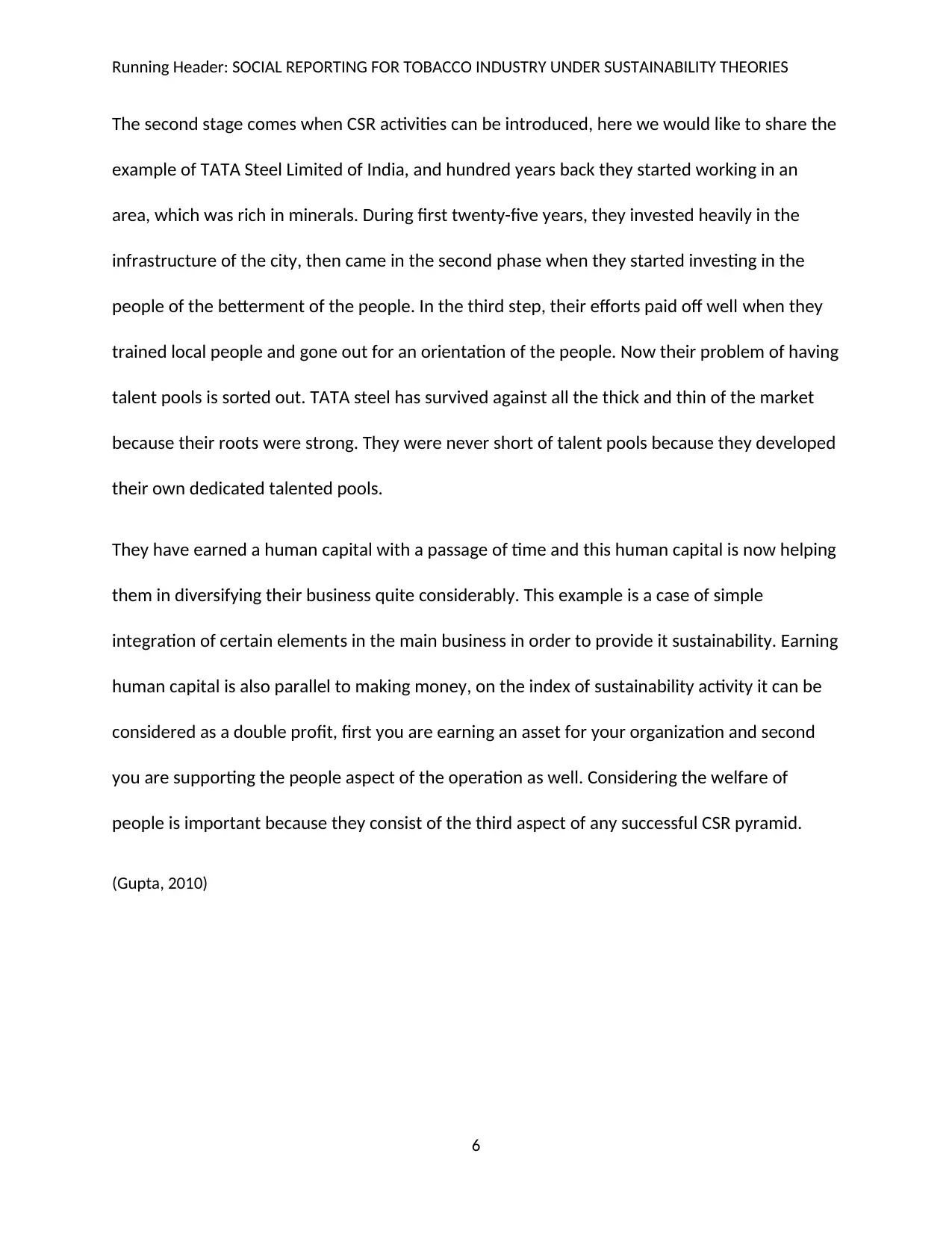
Running Header: SOCIAL REPORTING FOR TOBACCO INDUSTRY UNDER SUSTAINABILITY THEORIES
The second stage comes when CSR activities can be introduced, here we would like to share the
example of TATA Steel Limited of India, and hundred years back they started working in an
area, which was rich in minerals. During first twenty-five years, they invested heavily in the
infrastructure of the city, then came in the second phase when they started investing in the
people of the betterment of the people. In the third step, their efforts paid off well when they
trained local people and gone out for an orientation of the people. Now their problem of having
talent pools is sorted out. TATA steel has survived against all the thick and thin of the market
because their roots were strong. They were never short of talent pools because they developed
their own dedicated talented pools.
They have earned a human capital with a passage of time and this human capital is now helping
them in diversifying their business quite considerably. This example is a case of simple
integration of certain elements in the main business in order to provide it sustainability. Earning
human capital is also parallel to making money, on the index of sustainability activity it can be
considered as a double profit, first you are earning an asset for your organization and second
you are supporting the people aspect of the operation as well. Considering the welfare of
people is important because they consist of the third aspect of any successful CSR pyramid.
(Gupta, 2010)
6
The second stage comes when CSR activities can be introduced, here we would like to share the
example of TATA Steel Limited of India, and hundred years back they started working in an
area, which was rich in minerals. During first twenty-five years, they invested heavily in the
infrastructure of the city, then came in the second phase when they started investing in the
people of the betterment of the people. In the third step, their efforts paid off well when they
trained local people and gone out for an orientation of the people. Now their problem of having
talent pools is sorted out. TATA steel has survived against all the thick and thin of the market
because their roots were strong. They were never short of talent pools because they developed
their own dedicated talented pools.
They have earned a human capital with a passage of time and this human capital is now helping
them in diversifying their business quite considerably. This example is a case of simple
integration of certain elements in the main business in order to provide it sustainability. Earning
human capital is also parallel to making money, on the index of sustainability activity it can be
considered as a double profit, first you are earning an asset for your organization and second
you are supporting the people aspect of the operation as well. Considering the welfare of
people is important because they consist of the third aspect of any successful CSR pyramid.
(Gupta, 2010)
6
⊘ This is a preview!⊘
Do you want full access?
Subscribe today to unlock all pages.

Trusted by 1+ million students worldwide

Running Header: SOCIAL REPORTING FOR TOBACCO INDUSTRY UNDER SUSTAINABILITY THEORIES
The concept of Triple Bottom line
We have just discussed the case of Tata Motors and HZL or Hindustan Zinc limited. Both these
models are an example of strong sustainability. As we can see in the diagram, weak
sustainability model attracts CSR activity at the common part of the set created by three
spheres of activity, on the other hand, strong sustainability clubs all the three spheres in a
single big set where everything pushes the other thing in a forward direction.
(Elkington, 1999)
Companies like JTI cannot go for strong sustainability programs because their basic product is
harmful to the society. The moment they will start promoting their brands, things will go out of
their hands. The sphere of economy or profit will start eating up the interests of the people. For
7
The concept of Triple Bottom line
We have just discussed the case of Tata Motors and HZL or Hindustan Zinc limited. Both these
models are an example of strong sustainability. As we can see in the diagram, weak
sustainability model attracts CSR activity at the common part of the set created by three
spheres of activity, on the other hand, strong sustainability clubs all the three spheres in a
single big set where everything pushes the other thing in a forward direction.
(Elkington, 1999)
Companies like JTI cannot go for strong sustainability programs because their basic product is
harmful to the society. The moment they will start promoting their brands, things will go out of
their hands. The sphere of economy or profit will start eating up the interests of the people. For
7
Paraphrase This Document
Need a fresh take? Get an instant paraphrase of this document with our AI Paraphraser
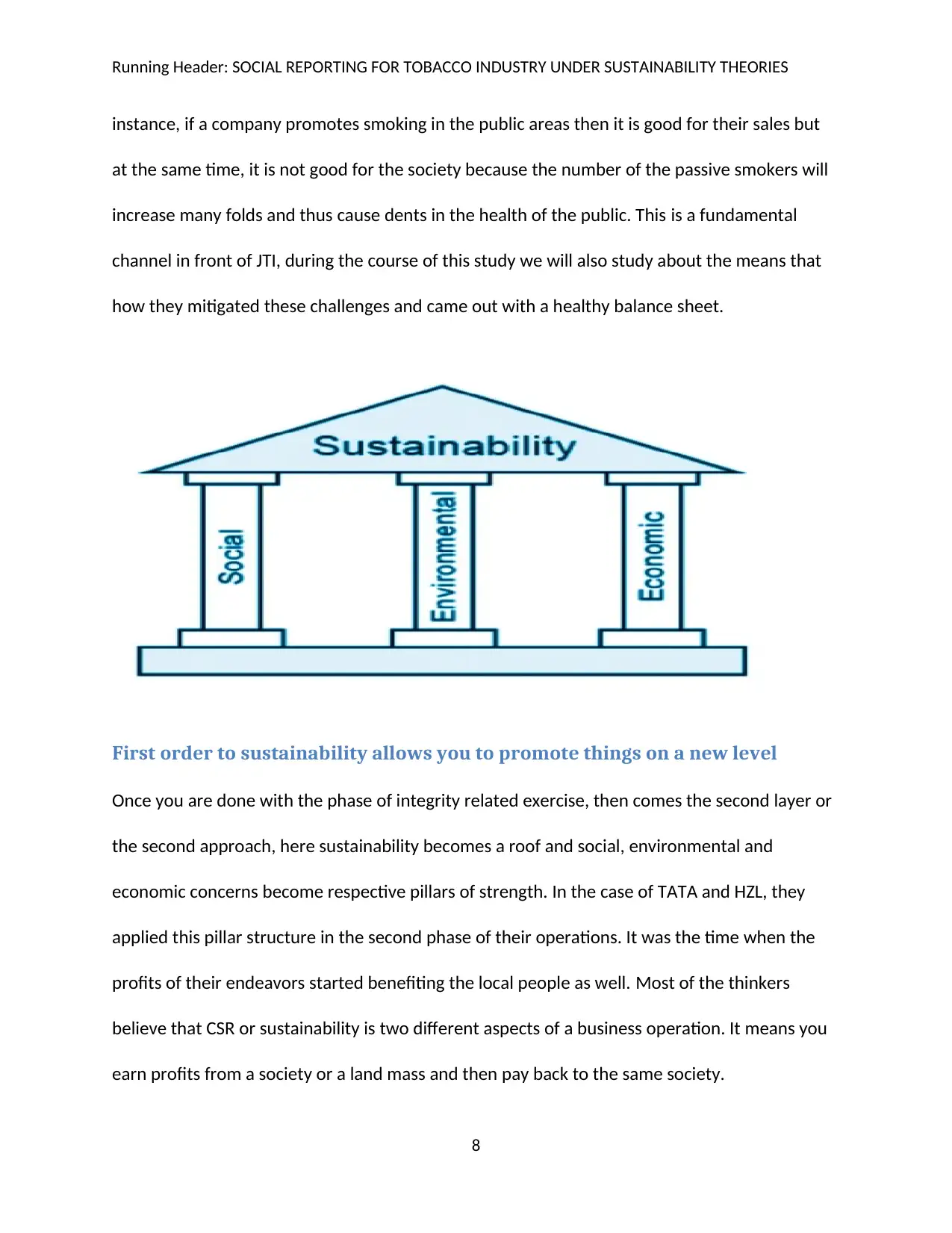
Running Header: SOCIAL REPORTING FOR TOBACCO INDUSTRY UNDER SUSTAINABILITY THEORIES
instance, if a company promotes smoking in the public areas then it is good for their sales but
at the same time, it is not good for the society because the number of the passive smokers will
increase many folds and thus cause dents in the health of the public. This is a fundamental
channel in front of JTI, during the course of this study we will also study about the means that
how they mitigated these challenges and came out with a healthy balance sheet.
First order to sustainability allows you to promote things on a new level
Once you are done with the phase of integrity related exercise, then comes the second layer or
the second approach, here sustainability becomes a roof and social, environmental and
economic concerns become respective pillars of strength. In the case of TATA and HZL, they
applied this pillar structure in the second phase of their operations. It was the time when the
profits of their endeavors started benefiting the local people as well. Most of the thinkers
believe that CSR or sustainability is two different aspects of a business operation. It means you
earn profits from a society or a land mass and then pay back to the same society.
8
instance, if a company promotes smoking in the public areas then it is good for their sales but
at the same time, it is not good for the society because the number of the passive smokers will
increase many folds and thus cause dents in the health of the public. This is a fundamental
channel in front of JTI, during the course of this study we will also study about the means that
how they mitigated these challenges and came out with a healthy balance sheet.
First order to sustainability allows you to promote things on a new level
Once you are done with the phase of integrity related exercise, then comes the second layer or
the second approach, here sustainability becomes a roof and social, environmental and
economic concerns become respective pillars of strength. In the case of TATA and HZL, they
applied this pillar structure in the second phase of their operations. It was the time when the
profits of their endeavors started benefiting the local people as well. Most of the thinkers
believe that CSR or sustainability is two different aspects of a business operation. It means you
earn profits from a society or a land mass and then pay back to the same society.
8
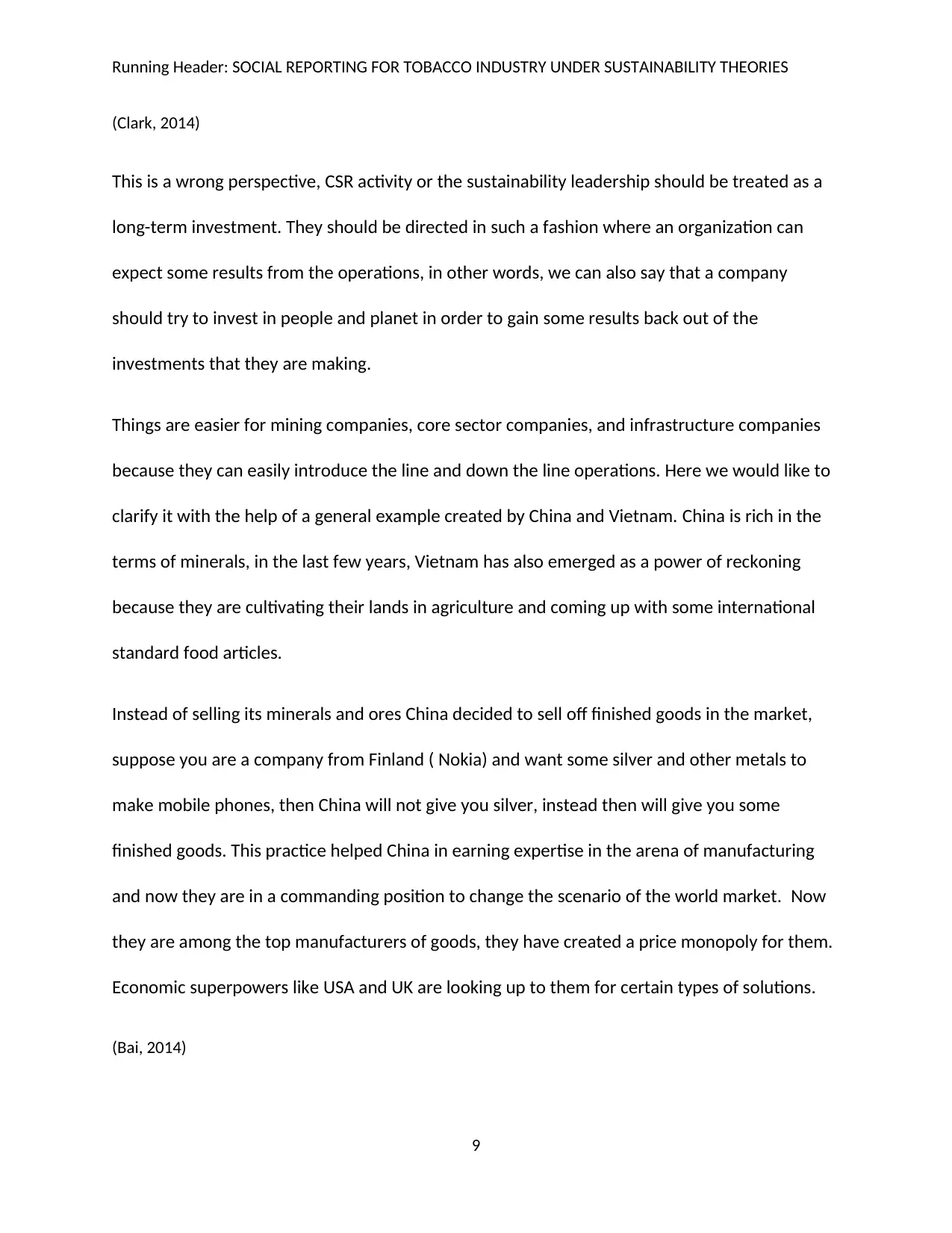
Running Header: SOCIAL REPORTING FOR TOBACCO INDUSTRY UNDER SUSTAINABILITY THEORIES
(Clark, 2014)
This is a wrong perspective, CSR activity or the sustainability leadership should be treated as a
long-term investment. They should be directed in such a fashion where an organization can
expect some results from the operations, in other words, we can also say that a company
should try to invest in people and planet in order to gain some results back out of the
investments that they are making.
Things are easier for mining companies, core sector companies, and infrastructure companies
because they can easily introduce the line and down the line operations. Here we would like to
clarify it with the help of a general example created by China and Vietnam. China is rich in the
terms of minerals, in the last few years, Vietnam has also emerged as a power of reckoning
because they are cultivating their lands in agriculture and coming up with some international
standard food articles.
Instead of selling its minerals and ores China decided to sell off finished goods in the market,
suppose you are a company from Finland ( Nokia) and want some silver and other metals to
make mobile phones, then China will not give you silver, instead then will give you some
finished goods. This practice helped China in earning expertise in the arena of manufacturing
and now they are in a commanding position to change the scenario of the world market. Now
they are among the top manufacturers of goods, they have created a price monopoly for them.
Economic superpowers like USA and UK are looking up to them for certain types of solutions.
(Bai, 2014)
9
(Clark, 2014)
This is a wrong perspective, CSR activity or the sustainability leadership should be treated as a
long-term investment. They should be directed in such a fashion where an organization can
expect some results from the operations, in other words, we can also say that a company
should try to invest in people and planet in order to gain some results back out of the
investments that they are making.
Things are easier for mining companies, core sector companies, and infrastructure companies
because they can easily introduce the line and down the line operations. Here we would like to
clarify it with the help of a general example created by China and Vietnam. China is rich in the
terms of minerals, in the last few years, Vietnam has also emerged as a power of reckoning
because they are cultivating their lands in agriculture and coming up with some international
standard food articles.
Instead of selling its minerals and ores China decided to sell off finished goods in the market,
suppose you are a company from Finland ( Nokia) and want some silver and other metals to
make mobile phones, then China will not give you silver, instead then will give you some
finished goods. This practice helped China in earning expertise in the arena of manufacturing
and now they are in a commanding position to change the scenario of the world market. Now
they are among the top manufacturers of goods, they have created a price monopoly for them.
Economic superpowers like USA and UK are looking up to them for certain types of solutions.
(Bai, 2014)
9
⊘ This is a preview!⊘
Do you want full access?
Subscribe today to unlock all pages.

Trusted by 1+ million students worldwide
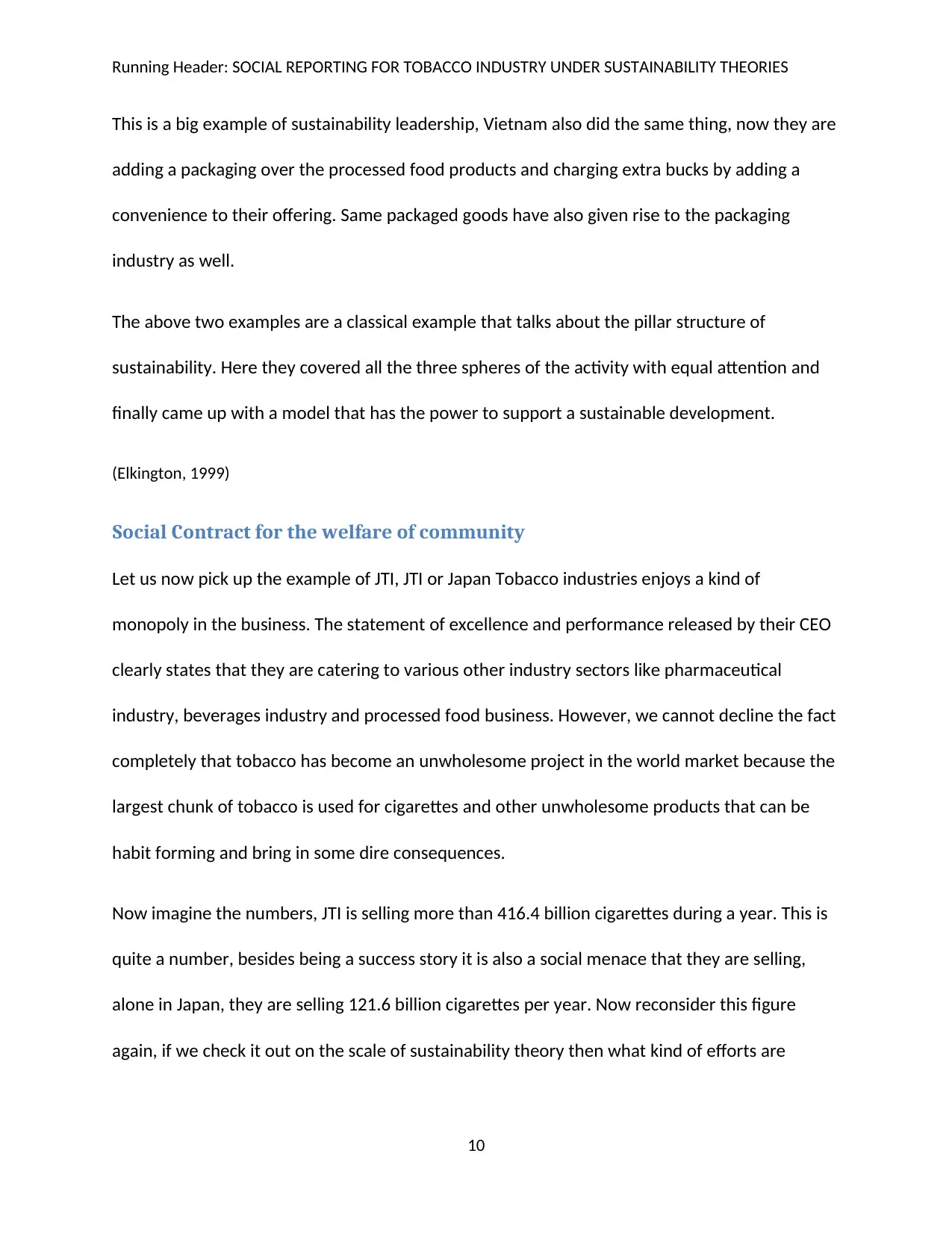
Running Header: SOCIAL REPORTING FOR TOBACCO INDUSTRY UNDER SUSTAINABILITY THEORIES
This is a big example of sustainability leadership, Vietnam also did the same thing, now they are
adding a packaging over the processed food products and charging extra bucks by adding a
convenience to their offering. Same packaged goods have also given rise to the packaging
industry as well.
The above two examples are a classical example that talks about the pillar structure of
sustainability. Here they covered all the three spheres of the activity with equal attention and
finally came up with a model that has the power to support a sustainable development.
(Elkington, 1999)
Social Contract for the welfare of community
Let us now pick up the example of JTI, JTI or Japan Tobacco industries enjoys a kind of
monopoly in the business. The statement of excellence and performance released by their CEO
clearly states that they are catering to various other industry sectors like pharmaceutical
industry, beverages industry and processed food business. However, we cannot decline the fact
completely that tobacco has become an unwholesome project in the world market because the
largest chunk of tobacco is used for cigarettes and other unwholesome products that can be
habit forming and bring in some dire consequences.
Now imagine the numbers, JTI is selling more than 416.4 billion cigarettes during a year. This is
quite a number, besides being a success story it is also a social menace that they are selling,
alone in Japan, they are selling 121.6 billion cigarettes per year. Now reconsider this figure
again, if we check it out on the scale of sustainability theory then what kind of efforts are
10
This is a big example of sustainability leadership, Vietnam also did the same thing, now they are
adding a packaging over the processed food products and charging extra bucks by adding a
convenience to their offering. Same packaged goods have also given rise to the packaging
industry as well.
The above two examples are a classical example that talks about the pillar structure of
sustainability. Here they covered all the three spheres of the activity with equal attention and
finally came up with a model that has the power to support a sustainable development.
(Elkington, 1999)
Social Contract for the welfare of community
Let us now pick up the example of JTI, JTI or Japan Tobacco industries enjoys a kind of
monopoly in the business. The statement of excellence and performance released by their CEO
clearly states that they are catering to various other industry sectors like pharmaceutical
industry, beverages industry and processed food business. However, we cannot decline the fact
completely that tobacco has become an unwholesome project in the world market because the
largest chunk of tobacco is used for cigarettes and other unwholesome products that can be
habit forming and bring in some dire consequences.
Now imagine the numbers, JTI is selling more than 416.4 billion cigarettes during a year. This is
quite a number, besides being a success story it is also a social menace that they are selling,
alone in Japan, they are selling 121.6 billion cigarettes per year. Now reconsider this figure
again, if we check it out on the scale of sustainability theory then what kind of efforts are
10
Paraphrase This Document
Need a fresh take? Get an instant paraphrase of this document with our AI Paraphraser
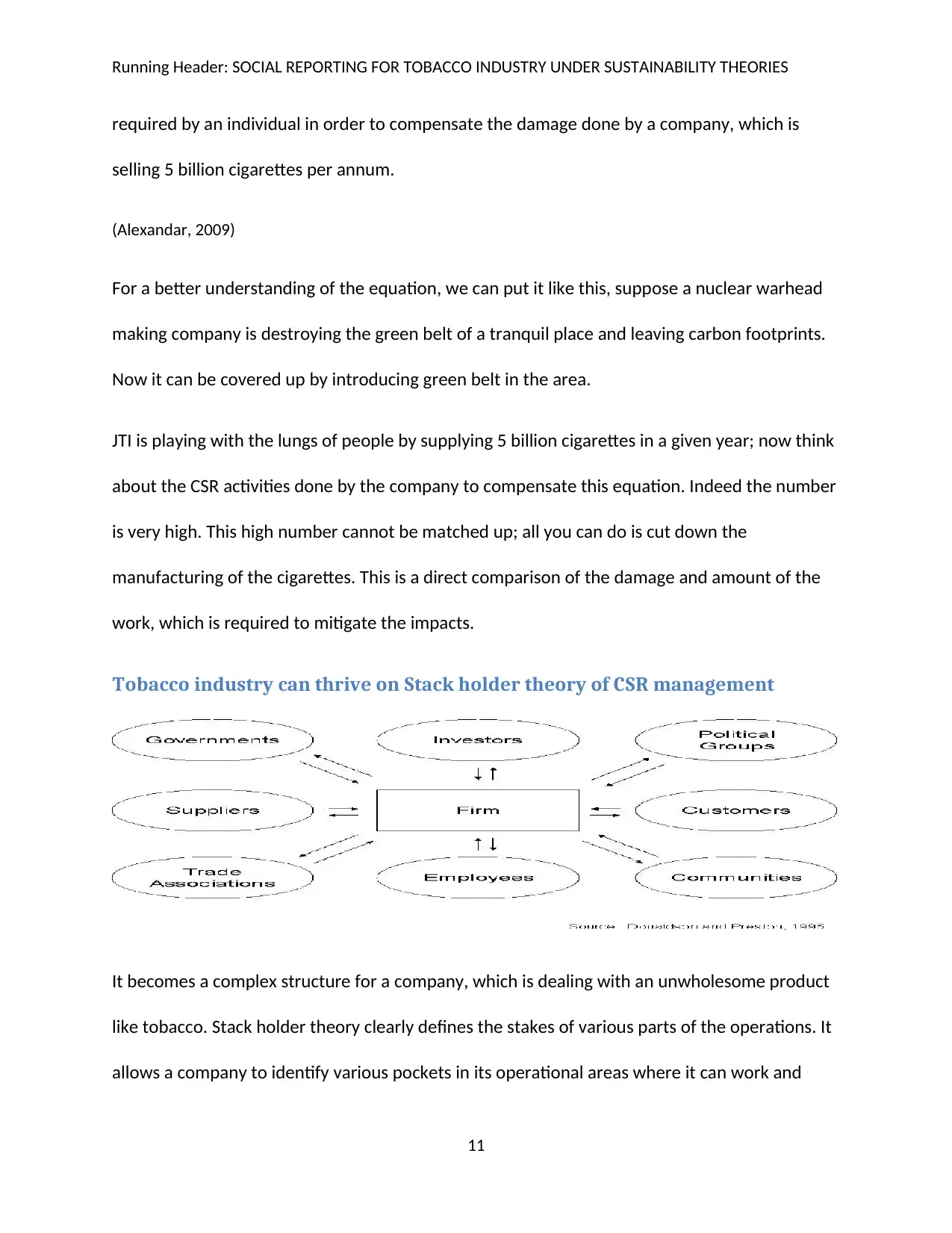
Running Header: SOCIAL REPORTING FOR TOBACCO INDUSTRY UNDER SUSTAINABILITY THEORIES
required by an individual in order to compensate the damage done by a company, which is
selling 5 billion cigarettes per annum.
(Alexandar, 2009)
For a better understanding of the equation, we can put it like this, suppose a nuclear warhead
making company is destroying the green belt of a tranquil place and leaving carbon footprints.
Now it can be covered up by introducing green belt in the area.
JTI is playing with the lungs of people by supplying 5 billion cigarettes in a given year; now think
about the CSR activities done by the company to compensate this equation. Indeed the number
is very high. This high number cannot be matched up; all you can do is cut down the
manufacturing of the cigarettes. This is a direct comparison of the damage and amount of the
work, which is required to mitigate the impacts.
Tobacco industry can thrive on Stack holder theory of CSR management
It becomes a complex structure for a company, which is dealing with an unwholesome product
like tobacco. Stack holder theory clearly defines the stakes of various parts of the operations. It
allows a company to identify various pockets in its operational areas where it can work and
11
required by an individual in order to compensate the damage done by a company, which is
selling 5 billion cigarettes per annum.
(Alexandar, 2009)
For a better understanding of the equation, we can put it like this, suppose a nuclear warhead
making company is destroying the green belt of a tranquil place and leaving carbon footprints.
Now it can be covered up by introducing green belt in the area.
JTI is playing with the lungs of people by supplying 5 billion cigarettes in a given year; now think
about the CSR activities done by the company to compensate this equation. Indeed the number
is very high. This high number cannot be matched up; all you can do is cut down the
manufacturing of the cigarettes. This is a direct comparison of the damage and amount of the
work, which is required to mitigate the impacts.
Tobacco industry can thrive on Stack holder theory of CSR management
It becomes a complex structure for a company, which is dealing with an unwholesome product
like tobacco. Stack holder theory clearly defines the stakes of various parts of the operations. It
allows a company to identify various pockets in its operational areas where it can work and
11
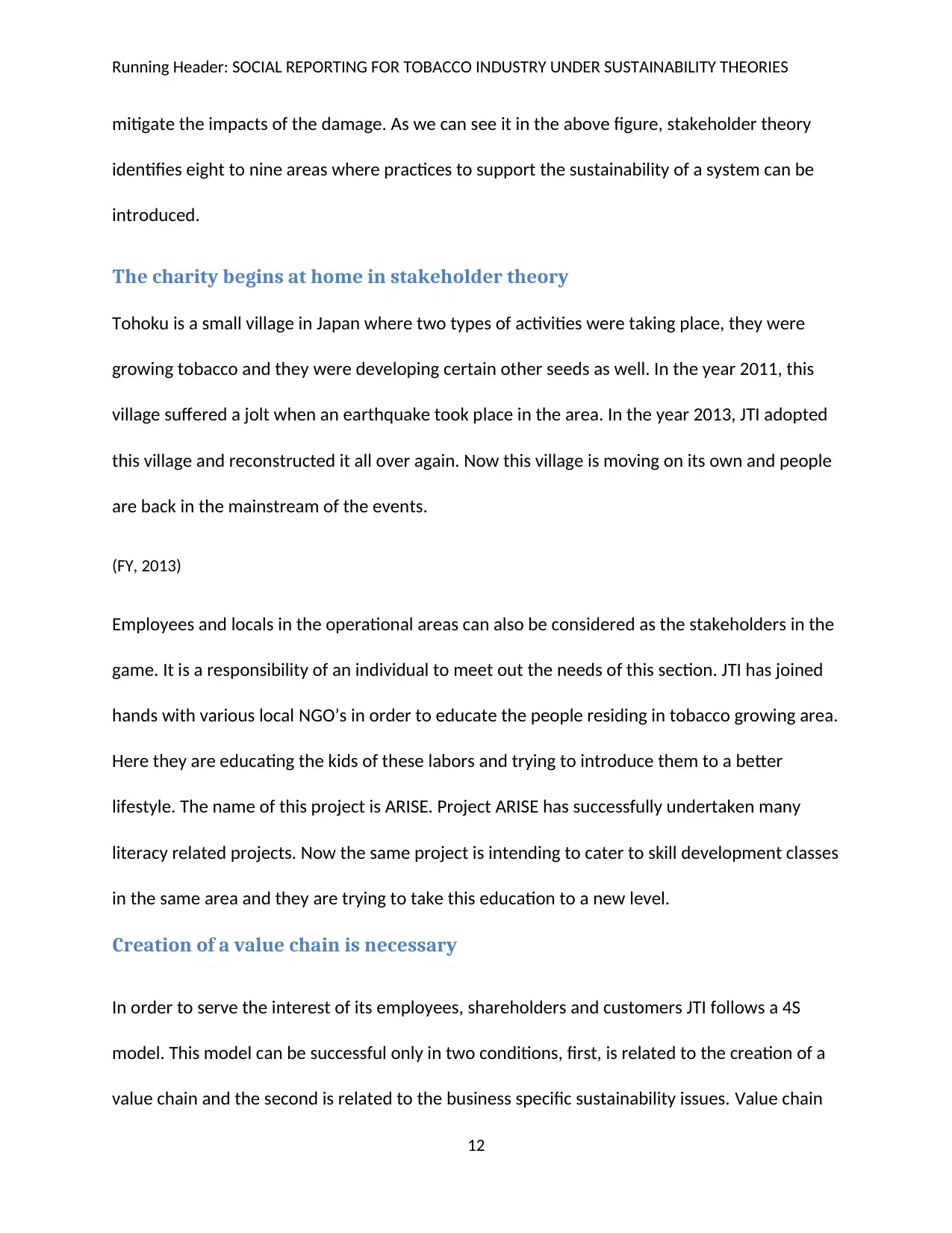
Running Header: SOCIAL REPORTING FOR TOBACCO INDUSTRY UNDER SUSTAINABILITY THEORIES
mitigate the impacts of the damage. As we can see it in the above figure, stakeholder theory
identifies eight to nine areas where practices to support the sustainability of a system can be
introduced.
The charity begins at home in stakeholder theory
Tohoku is a small village in Japan where two types of activities were taking place, they were
growing tobacco and they were developing certain other seeds as well. In the year 2011, this
village suffered a jolt when an earthquake took place in the area. In the year 2013, JTI adopted
this village and reconstructed it all over again. Now this village is moving on its own and people
are back in the mainstream of the events.
(FY, 2013)
Employees and locals in the operational areas can also be considered as the stakeholders in the
game. It is a responsibility of an individual to meet out the needs of this section. JTI has joined
hands with various local NGO’s in order to educate the people residing in tobacco growing area.
Here they are educating the kids of these labors and trying to introduce them to a better
lifestyle. The name of this project is ARISE. Project ARISE has successfully undertaken many
literacy related projects. Now the same project is intending to cater to skill development classes
in the same area and they are trying to take this education to a new level.
Creation of a value chain is necessary
In order to serve the interest of its employees, shareholders and customers JTI follows a 4S
model. This model can be successful only in two conditions, first, is related to the creation of a
value chain and the second is related to the business specific sustainability issues. Value chain
12
mitigate the impacts of the damage. As we can see it in the above figure, stakeholder theory
identifies eight to nine areas where practices to support the sustainability of a system can be
introduced.
The charity begins at home in stakeholder theory
Tohoku is a small village in Japan where two types of activities were taking place, they were
growing tobacco and they were developing certain other seeds as well. In the year 2011, this
village suffered a jolt when an earthquake took place in the area. In the year 2013, JTI adopted
this village and reconstructed it all over again. Now this village is moving on its own and people
are back in the mainstream of the events.
(FY, 2013)
Employees and locals in the operational areas can also be considered as the stakeholders in the
game. It is a responsibility of an individual to meet out the needs of this section. JTI has joined
hands with various local NGO’s in order to educate the people residing in tobacco growing area.
Here they are educating the kids of these labors and trying to introduce them to a better
lifestyle. The name of this project is ARISE. Project ARISE has successfully undertaken many
literacy related projects. Now the same project is intending to cater to skill development classes
in the same area and they are trying to take this education to a new level.
Creation of a value chain is necessary
In order to serve the interest of its employees, shareholders and customers JTI follows a 4S
model. This model can be successful only in two conditions, first, is related to the creation of a
value chain and the second is related to the business specific sustainability issues. Value chain
12
⊘ This is a preview!⊘
Do you want full access?
Subscribe today to unlock all pages.

Trusted by 1+ million students worldwide
1 out of 16
Your All-in-One AI-Powered Toolkit for Academic Success.
+13062052269
info@desklib.com
Available 24*7 on WhatsApp / Email
![[object Object]](/_next/static/media/star-bottom.7253800d.svg)
Unlock your academic potential
Copyright © 2020–2025 A2Z Services. All Rights Reserved. Developed and managed by ZUCOL.